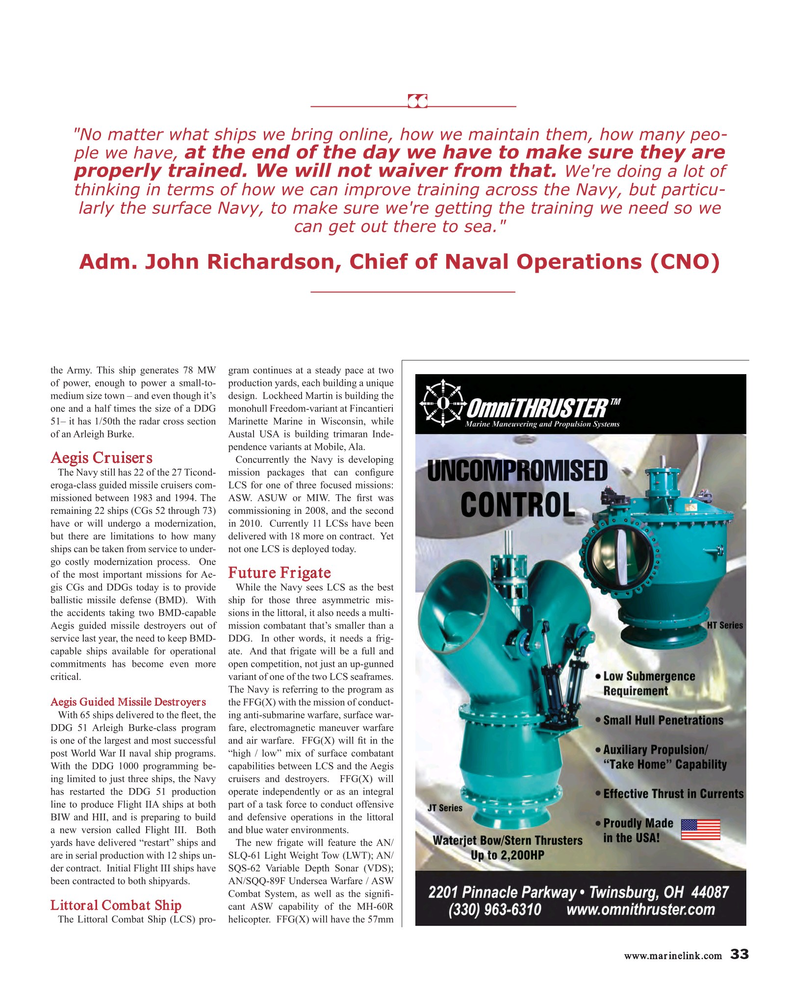
Page 33: of Maritime Reporter Magazine (March 2018)
Annual World Yearbook
Read this page in Pdf, Flash or Html5 edition of March 2018 Maritime Reporter Magazine
“ "No matter what ships we bring online, how we maintain them, how many peo- ple we have, at the end of the day we have to make sure they are properly trained. We will not waiver from that. We're doing a lot of thinking in terms of how we can improve training across the Navy, but particu- larly the surface Navy, to make sure we're getting the training we need so we can get out there to sea."
Adm. John Richardson, Chief of Naval Operations (CNO) the Army. This ship generates 78 MW gram continues at a steady pace at two of power, enough to power a small-to- production yards, each building a unique medium size town – and even though it’s design. Lockheed Martin is building the one and a half times the size of a DDG monohull Freedom-variant at Fincantieri 51– it has 1/50th the radar cross section Marinette Marine in Wisconsin, while of an Arleigh Burke. Austal USA is building trimaran Inde- pendence variants at Mobile, Ala.
Aegis Cruisers Concurrently the Navy is developing
The Navy still has 22 of the 27 Ticond- mission packages that can con? gure eroga-class guided missile cruisers com- LCS for one of three focused missions: missioned between 1983 and 1994. The ASW. ASUW or MIW. The ? rst was remaining 22 ships (CGs 52 through 73) commissioning in 2008, and the second have or will undergo a modernization, in 2010. Currently 11 LCSs have been but there are limitations to how many delivered with 18 more on contract. Yet ships can be taken from service to under- not one LCS is deployed today.
go costly modernization process. One of the most important missions for Ae- Future Frigate gis CGs and DDGs today is to provide While the Navy sees LCS as the best ballistic missile defense (BMD). With ship for those three asymmetric mis- the accidents taking two BMD-capable sions in the littoral, it also needs a multi-
Aegis guided missile destroyers out of mission combatant that’s smaller than a service last year, the need to keep BMD- DDG. In other words, it needs a frig- capable ships available for operational ate. And that frigate will be a full and commitments has become even more open competition, not just an up-gunned critical. variant of one of the two LCS seaframes.
The Navy is referring to the program as
Aegis Guided Missile Destroyers the FFG(X) with the mission of conduct-
With 65 ships delivered to the ? eet, the ing anti-submarine warfare, surface war-
DDG 51 Arleigh Burke-class program fare, electromagnetic maneuver warfare is one of the largest and most successful and air warfare. FFG(X) will ? t in the post World War II naval ship programs. “high / low” mix of surface combatant
With the DDG 1000 programming be- capabilities between LCS and the Aegis ing limited to just three ships, the Navy cruisers and destroyers. FFG(X) will has restarted the DDG 51 production operate independently or as an integral line to produce Flight IIA ships at both part of a task force to conduct offensive
BIW and HII, and is preparing to build and defensive operations in the littoral a new version called Flight III. Both and blue water environments.
yards have delivered “restart” ships and The new frigate will feature the AN/ are in serial production with 12 ships un- SLQ-61 Light Weight Tow (LWT); AN/ der contract. Initial Flight III ships have SQS-62 Variable Depth Sonar (VDS); been contracted to both shipyards. AN/SQQ-89F Undersea Warfare / ASW
Combat System, as well as the signi? -
Littoral Combat Ship cant ASW capability of the MH-60R
The Littoral Combat Ship (LCS) pro- helicopter. FFG(X) will have the 57mm www.marinelink.com 33
MR #3 (26-33).indd 33 MR #3 (26-33).indd 33 3/5/2018 12:43:25 PM3/5/2018 12:43:25 PM

 32
32

 34
34
